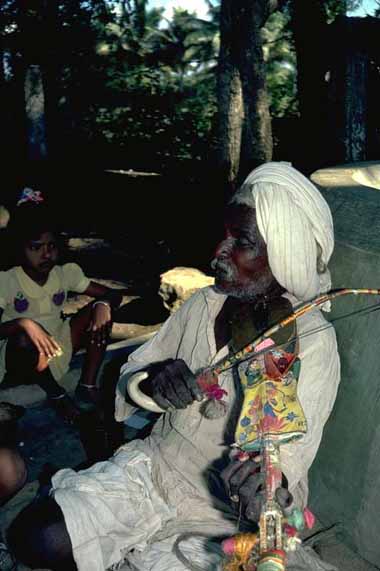An Overview of the Folk Music of the Indian Subcontinent.

India has a very rich tradition of folk music. The extreme cultural diversity creates endless varieties of styles. Each region has its own particular style.
There is a tendency to lump folk music along with tribal music. There is actually a difference. Where folk music is a mere rustic reflection of the larger Indian society, tribal music often represents cultures that are very different. Some of these tribal cultures treace back thousands of years.
Tribal and folk music is not taught in the same way as classical Indian music. There is no formal period of apprenticeship where the student is able to devote their entire life to learning the music; the economics of rural life does not permit this sort of thing. The musical practitioners must still attend to their normal duties of hunting, agriculture, or whatever their chosen profession is.
Music in the villages is learned almost by osmosis. From childhood the music is heard and imbibed along with one’s mother’s milk. There are numerous public activities that allow the villagers to practice and hone their skills. These are the normal functions which synchronise village life with the universe.
The music is an indispensable component of functions such as weddings, engagements, and births. There is a plethora of songs for such occasions. There are also many songs associated with planting and harvesting. In these activities the villagers routinely sing of their hopes, fears, and aspirations.
Folk music is also used for educational purposes. For instance sex education has traditionally been taught in Andhra Pradesh by song. There is a function when a girl has her first menses. In this function the elderly women in the community gather at the house (men are definitely excluded), the girl is given her first woni and langa (half sari which is worn by unmarried girls), rich food and other gifts. During this function the women sing songs that are extremely bawdy. To an outsider this would seem uncharacteristic of obviously respectable community members. However the function of such songs is to provide the girl’s first instructions on her emerging womanhood and what her future marital duties will be.
Musical instruments are often different from those found in classical music. Although instruments like the tabla may sometimes be found it is more likely that cruder drums such as daf, dholak, or nal will be used. The sitar and sarod which are so common in the classical genre are absent. One often finds instruments such as the ektar, dotar, saringda, rabab, and santur. Quite often they will not even be called these names, but may be named according to their local dialect. There are also instruments which are used only in particular folk styles in particular regions. These instruments are innumerable.
The instruments that folk musicians use are generally not as refined as those of the classical musicians. The instruments of classical music are crafted by artisans whose only job is their fabrication. In contrast the folk instruments are commonly crafted by the musicians themselves.
It is very common to find folk instruments that have been made of commonly available materials. Skin, peritoneum, bamboo, coconut shells, and pots are but a few commonly available materials used to make musical instruments.
- Bhangra – Music and Dance from the Punjab
- Vaoaiya (Bhawaia) (Part 1) – Folk music of Northern Bagladesh (Introduction)
- Vaoaiya (Bhawaia) (Part 2) – Folk music of Northern Bagladesh (Music and Texts)
- Vaoaiya (Bhawaia) (Part 3) – Folk music of Northern Bagladesh (Glossary, Misc., Works Cited)
- Kushan – Folk theatre of Bangladesh
Selected Video
Other Sites of Interest
India : North Indian folk music
